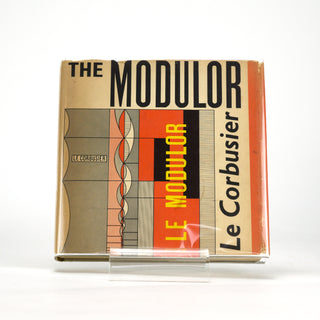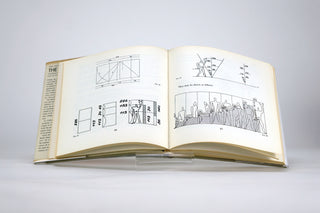Le Corbusier developed the concept of the Modulor as a kind of modern response to previous systems for a scientific, human-centric design approach such as was originated by Vitruvius, Leonardo da Vinci, and Leon Battista Alberti. The goal was to improve both the appearance and function of architecture. Le Corbusier described it as a "range of harmonious measurements to suit the human scale, universally applicable to architecture and to mechanical things".
In 1943, in response to the French National Organisation for Standardisation's (AFNOR) requirement for standardising all the objects involved in the construction process, Le Corbusier asked an apprentice to consider a scale based upon a man with his arm raised to 2.20m in height (note he specifies a man, and a French man at that.) The result, in August 1943 was the first graphical representation of the derivation of the scale. This “scientific” and pragmatic approach left Le Corbusier wide open to critics, who not only questioned whether such a system could truly be universally applied, but also how it could inhibit innovation and experimentation. Nevertheless, The Modulor continues to be very influential and it does give us a window into how he applied it to so man of this projects. Profusely illustrated with many of the architect’s own hand-drawings, The Modulor is a fascinating study into the theoretical and practical tenets of modern architecture.
Very fine edition, with immaculate boards and solid binding. Includes original dust jacket which has some minor chips and corner tears; otherwise fine and clean, and protected by a Mylar jacket.
Le Corbusier developed the concept of the Modulor as a kind of modern response to previous systems for a scientific, human-centric design approach such as was originated by Vitruvius, Leonardo da Vinci, and Leon Battista Alberti. The goal was to improve both the appearance and function of architecture. Le Corbusier described it as a "range of harmonious measurements to suit the human scale, universally applicable to architecture and to mechanical things".
In 1943, in response to the French National Organisation for Standardisation's (AFNOR) requirement for standardising all the objects involved in the construction process, Le Corbusier asked an apprentice to consider a scale based upon a man with his arm raised to 2.20m in height (note he specifies a man, and a French man at that.) The result, in August 1943 was the first graphical representation of the derivation of the scale. This “scientific” and pragmatic approach left Le Corbusier wide open to critics, who not only questioned whether such a system could truly be universally applied, but also how it could inhibit innovation and experimentation. Nevertheless, The Modulor continues to be very influential and it does give us a window into how he applied it to so man of this projects. Profusely illustrated with many of the architect’s own hand-drawings, The Modulor is a fascinating study into the theoretical and practical tenets of modern architecture.
Very fine edition, with immaculate boards and solid binding. Includes original dust jacket which has some minor chips and corner tears; otherwise fine and clean, and protected by a Mylar jacket.



